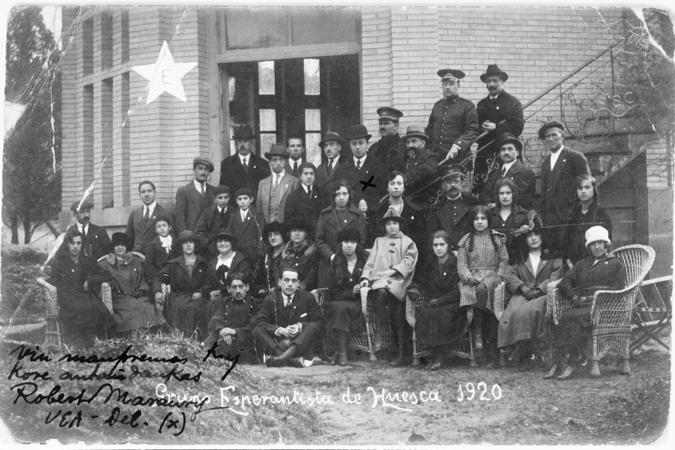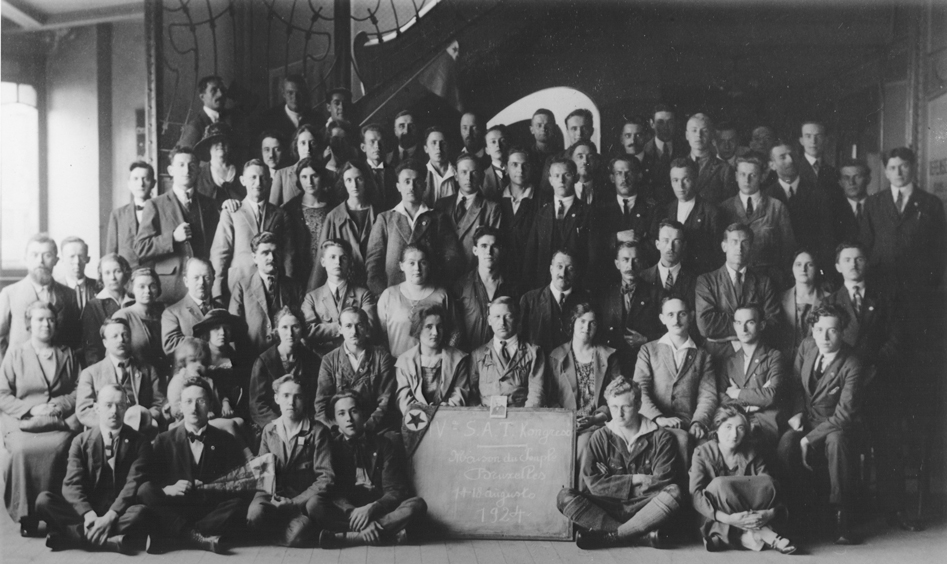
United States Holocaust Memorial Museum — Photo Archives — Esperanto
Meeting of Esperanto speakers in Huesco, Spain. [Photograph #61563]

Meeting of Esperanto speakers in Huesco, Spain.
Among those pictured is Joseph Mordechai Halter.
Date: Apr 1920
Locale: Spain
Credit: USHMM, courtesy of Paul Halter
Copyright: USHMMSubject Classification:
LIFE BEFORE THE HOLOCAUST -- SwitzerlandKeywords:
GROUP PORTRAITS
ESPERANTO
CONFERENCES/CONVENTIONS
JEWS (SWISS)[Kunveno de Esperantistoj en Huesco, Hispanio, aprilon 1920. Inter la partoprenantoj en la fotografo estas Joseph Mordechai Halter. — RD]
Annual conference of Esperanto speakers in Brussels, Belgium. [Photograph #63673]

Annual conference of Esperanto speakers in Brussels, Belgium.
[Source: Paul Halter and Merry Hermanus, Paul Halter: Numero 151.610; Brussels; Editions Labor; 2004.]
Date: Aug 14, 1924 - Aug 18, 1924
Locale: Brussels, [Brabant] Belgium; Bruxelles
Credit: USHMM, courtesy of Paul Halter
Copyright: USHMMSubject Classification:
LIFE BEFORE THE HOLOCAUST -- BelgiumKeywords:
GROUP PORTRAITS
SOCIAL CLUBS
ESPERANTO
MEETINGS
CONFERENCES/CONVENTIONS[Jara kongreso de Esperantistoj en Bruselo, Belgio, aŭguston 1924. — RD]
|
Traduko en Esperanto de Ralph Dumain
|
"Al la Juda Foririnto" de Lodewijk Cornelius Deij
Nazia apokalipso / Varsovia geto de Rikardo Ŝulco
“Radnóti” de Emeriko [Imre] Szabó
“Odo hezita” de Miklós Radnóti, trad. Márton Fejes
“Razglednica” de Miklós Radnóti, trad. K. Kalocsay
Esperanto & interlinguistics Study Guide / Retgvidilo pri Esperanto & interlingvistiko
Esperanto & Laborista Movado / Esperanto & the Labor Movement
On other sites / Alireteje:
United States Holocaust Memorial Museum
Home Page | Site
Map | What's New | Coming Attractions | Book
News
Bibliography | Mini-Bibliographies | Study
Guides | Special Sections
My Writings | Other Authors' Texts | Philosophical
Quotations
Blogs | Images
& Sounds | External Links
CONTACT Ralph Dumain
Uploaded 4 April 2007
Site ©1999-2021 Ralph Dumain